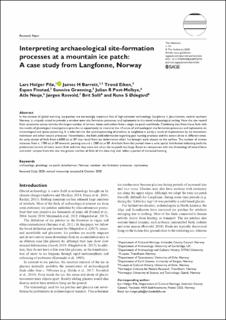| dc.contributor.author | Solli, Brit | |
| dc.contributor.author | Pilø, Lars Holger | |
| dc.contributor.author | Barrett, James H | |
| dc.contributor.author | Eiken, Trond | |
| dc.contributor.author | Finstad, Espen | |
| dc.contributor.author | Grønning, Sunniva | |
| dc.contributor.author | Post-Melbye, Julian R. | |
| dc.contributor.author | Nesje, Atle | |
| dc.contributor.author | Rosvold, Jørgen | |
| dc.contributor.author | Ødegård, Rune Strand | |
| dc.date.accessioned | 2020-12-07T10:47:07Z | |
| dc.date.available | 2020-12-07T10:47:07Z | |
| dc.date.created | 2020-12-03T16:55:32Z | |
| dc.date.issued | 2020 | |
| dc.identifier.citation | The Holocene. 2020, . | en_US |
| dc.identifier.issn | 0959-6836 | |
| dc.identifier.uri | https://hdl.handle.net/11250/2712135 | |
| dc.description.abstract | In the context of global warming, ice patches are increasingly important foci of high-elevation archaeology. Langfonne in Jotunheimen, central southern Norway, is uniquely suited to provide a window onto site formation processes and taphonomy in this novel archaeological setting. Here the site record from systematic survey includes the largest number of arrows, bones and antlers from a single ice patch worldwide. Combining data from these finds with the results of glaciological investigations provides an opportunity to interpret the influence of archaeological site formation processes and taphonomy on chronological and spatial patterning. It is inferred that the spatial patterning of artefacts at Langfonne is partly a result of displacement by ice movement, meltwater and other natural processes. Nevertheless, the finds yield information regarding past hunting practices and the extent of ice at different times. An early cluster of finds from c.6000 cal yr BP may result from ice deformation which has brought early objects to the surface. The number of arrows increases from c. 1700 cal yr BP onwards, peaking around c.1200 cal yr BP. Artefacts from this period show a wide spatial distribution indicating both the preferential survival of more recent finds and that they were lost when the ice patch was large. Based on comparison with the chronology of natural bone and antler samples from the site, the greater number of finds of this date may also reflect a period of increased hunting. | en_US |
| dc.language.iso | eng | en_US |
| dc.publisher | Sage Publications | en_US |
| dc.rights | Navngivelse-Ikkekommersiell 4.0 Internasjonal | * |
| dc.rights.uri | http://creativecommons.org/licenses/by-nc/4.0/deed.no | * |
| dc.title | Interpreting archaeological site-formation processes at a mountain ice patch: A case study from Langfonne, Norway | en_US |
| dc.type | Peer reviewed | en_US |
| dc.type | Journal article | en_US |
| dc.description.version | publishedVersion | en_US |
| dc.source.pagenumber | 14 | en_US |
| dc.source.journal | The Holocene | en_US |
| dc.identifier.doi | 10.1177/0959683620972775 | |
| dc.identifier.cristin | 1855966 | |
| dc.description.localcode | © The Author(s) 2020 This manuscript version is made available under the CC-BY-NC 4.0 license http://creativecommons.org/licenses/by-nc/4.0/ DOI: 10.1177/0959683620972775 journals.sagepub.com/home/hol. | en_US |
| cristin.ispublished | true | |
| cristin.fulltext | original | |
| cristin.qualitycode | 1 | |

